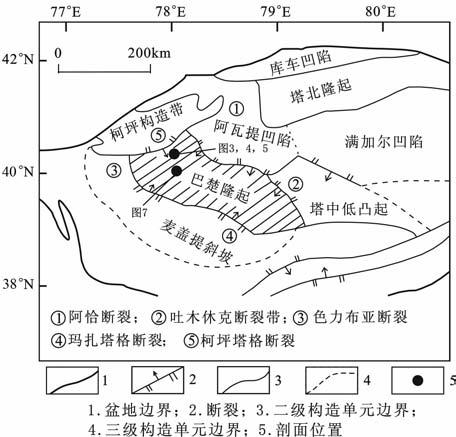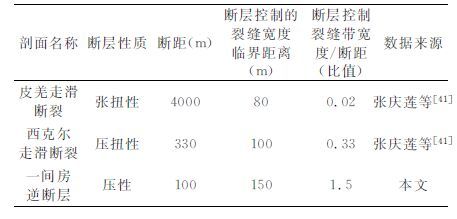2. 塔里木油田分公司勘探开发研究院,新疆库尔勒 814000
2. Tarim Petroleum Exploration and Development Institute, PetroChina, Korla, Xinjiang, 814000, China
火山岩和碳酸盐岩均属于致密岩石,致密岩石内广泛发育的裂缝主要为构造裂缝.1996年美国地球物理学家协会SEG 出版《Seismic Anisotropy》一书归纳了前人研究成果,全面介绍了地震各向异性以及裂缝诱导的各向异性理论、方法、实验与应用[1].用地震方法进行裂缝检测先后经历了横波勘探、多波多分量勘探和纵波裂缝检测几个阶段[2, 3].近年来国内也相应地开展了利用地震波进行裂缝检测的方法研究,并用于火山岩、碳酸盐岩、砂岩和泥岩的裂缝检测[4~10].目前,已普遍使用Hudson[11, 12]提出的裂隙介质理论来计算裂隙储层的等效弹性参数和裂隙密度.20 世纪70 年代末和80 年代初,国内以王仁(1979)、曾锦光(1982)等为代表从构造应力场入手,根据岩石破裂准则开展定量预测裂缝分布规律的数值模拟方法探讨[13, 14].Van Golf-Racht(1989)的《裂缝油藏工程基础》标志构造裂缝的预测进入定量研究阶段,主要利用弹性有限单元数值计算方法模拟构造应力场,根据岩石力学实验和物性参数分析裂缝的分布和力学性质[15].20 世纪80 年代初国际上开始研究裂缝的定量描述方法,最早主要是对岩芯裂缝进行裂缝性质、产状和线密度的统计.侯贵廷(1994)利用分形的方法对构造裂缝进行分析[16].近些年,裂缝的定量研究十分重视不同类型构造控制裂缝分布规律的数字建模研究,以研究各类构造如逆断层控制裂缝发育的问题[17~19].
逆断层如何控制裂缝的发育是塔里木油田油藏数值模拟的基础,塔中地区发育逆断层,如I号断裂带.在I号断裂带2km 的范围内裂缝相对密集,而远离断裂带的区域裂缝相对不发育(图 1),但这仅仅是一种定性的规律.裂缝分布规律的地震反演和解释需要搞清构造裂缝分布与断裂的性质和规模之间的定量关系.本文通过对塔里木盆地北缘两条逆断层及其附近发育的构造裂缝进行系统的测量与统计,分析逆断层对构造裂缝发育的控制因素及裂缝分布规律.

|
图 1 塔中I号断裂带及裂缝分布的地震反演图像 Fig. 1 Seismic image of Fault I zone and fractures in the center of Tarim basin |
构造测量选取的研究对象是位于塔里木盆地北缘巴楚地区的微波塔逆断层和一间房逆断层.通过对该区构造裂缝的面密度的系统测量,统计分析了裂缝面密度的分布规律,提出逆断层控制构造裂缝分布的规律和数学模型,并探讨断裂性质、断面的曲率和地层曲率等因素与构造裂缝面密度分布的关系.
2 研究区地质背景及研究方法概述 2.1 地质背景介绍研究区位于塔里木盆地西北缘柯坪-巴楚地区,区域构造位置处于柯坪塔格构造带和巴楚隆起的结合部位(图 2),是塔里木盆地的一个次级构造单元[20~22].研究区构造类型多为逆冲推覆构造,主要形成于新近纪.古生代时期,柯坪构造带和巴楚隆起区在前中生代是连为一体的,同属塔里木盆地的组成部分[23].中生代柯坪构造带、巴楚隆起形成雏形,并且它们之间的断裂活动加强[24~27].
新近纪以来由于印度板块与欧亚板块碰撞的远距离效应和西南天山地区板内造山影响,在上新世末-更新世初柯坪构造带沿柯坪塔格-沙井子断裂发生强烈挤压形成柯坪构造带,逆冲到巴楚隆起的北部之上[23, 28, 29].柯坪构造带由五排逆冲推覆构造带组成,近北东东向,其中,该构造带最南缘的柯坪塔格构造为最大的逆冲推覆构造带.巴楚隆起表现为一个复式断背斜,在北部出露地表,区域断裂以北西走向为主[26, 27, 30~32].本文的两条构造裂缝实测剖面均位于巴楚隆起的北部,微波塔逆断层与一间房逆断层切割二叠纪岩墙,并被新生代的柯坪塔格构造带逆掩推覆,说明巴楚隆起上的这些构造是中生代构造.
2.2 研究方法概述野外构造裂缝测量要求首先识别野外露头中的构造裂缝,构造裂缝特征如下:①构造裂缝分布较规则,常成组出现,有的呈共轭节理或雁列状分布;②有的构造裂缝局部或全部被矿脉(如方解石、石英等)充填;③ 构造裂缝面上有擦痕、阶步、羽饰等现象;④构造裂缝切穿深度较大,有的可穿数层[33~37].在研究构造作用对裂缝发育规律影响的时候,选择的剖面要求岩性单一、层厚变化不大和构造因素单一.基于以上要求,我们选择微波塔逆断层剖面和一间房南逆断层剖面两条剖面研究逆断层对构造裂缝发育的影响.
影响储层储集性的裂缝参数中,裂缝密度是最重要的物性参数.裂缝密度可分为线密度、面密度和体密度.由于线密度不能真实体现裂缝的密度,仅为相对密度,而体密度虽然能真实反映裂缝密度,但难以测量[15, 38~40],因此本文应用构造裂缝的面密度来研究构造裂缝的发育分布规律.面密度的计算公式为

|
其中,f为面密度(m-1);Li为测点内每条裂缝的长度(m);a为测点区域的长(m);b为测点区域的宽(m).
影响逆断层剖面上构造裂缝面密度的因素中,断层断面的曲率和地层曲率是很重要的参数[31].曲线曲率是对该曲线方程求二次导数,对于复杂的任意曲线上某点求二次导数可用近似逼近的方法.对于任意曲线上某点(x,y),取一无限小值Δx,假设x-Δx处y值为y1,x+Δx处y值为y2,则(x,y)点曲率为

|
因此可以根据剖面测点照片求出剖面上断层的断面或地层任意点的曲率(表 1),再对剖面上各测点的曲率与裂缝面密度关系进行研究讨论.
|
|
表 1 各剖面构造裂缝面密度测量数据统计结果表 Table 1 The caculation results of fracture density of sections |
微波塔逆断层是一个典型的逆断层.该逆断层中部被侵蚀成负地形,而出露了断层下盘的新地层上奥陶统良里塔格组灰岩.微波塔逆断层断面上的擦痕产状为17°∠24°左侧伏80°.主断面上的压性劈理和透镜体指示上盘向南南西逆冲.上盘为下奥陶统一间房组灰岩.该剖面主要研究不同位置断面曲率和不同地层曲率对构造裂缝分布的控制(图 3a).
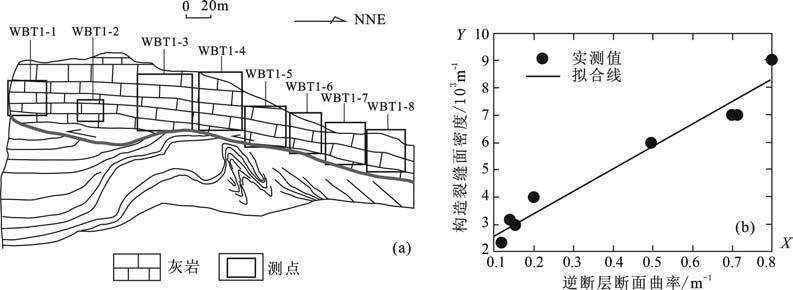
|
图 3 微波塔逆断层(南侧)上盘构造裂缝实测剖面WBT1及裂缝面密度线性拟合图 (a)构造裂缝实测剖面;(b)裂缝面密度-断面曲率关系的拟合图. Fig. 3 Profile of structural fracture measurement in the southern upper wall of WBT reverse faultand the fitted line between fracture density and curvature of fault plane. (a) Profile of structural fracture measurement; (b) Fitted line of fracture density and the curvature of fault plane. |
根据微波塔逆断层(南侧)剖面的构造裂缝面密度统计结果分析显示,点3、4面密度最大,点2、7、8面密度最小.很明显可以看出点3 和点4 断面曲率最大,而点2、7、8的断面曲率最小(表 1).微波塔逆断层(南侧)剖面上盘的构造裂缝面密度和断面曲率的线性拟合图满足方程y=0.0083x+0.0017,其中相关系数r=0.9811,逆断面曲率越大的地方其上盘构造裂缝面密度越大(图 3b).因此,根据逆断层断面的曲率可以预测构造裂缝发育程度的相对大小.
3.1.2 微波塔逆断层(南侧)下盘WBT2剖面由于逆冲作用,下盘软地层受到牵引发生了褶皱,褶皱轴面方向也指示向南南西方向逆冲.该剖面主要研究剖面上不同位置地层曲率与构造裂缝面密度之间的关系(图 4a).
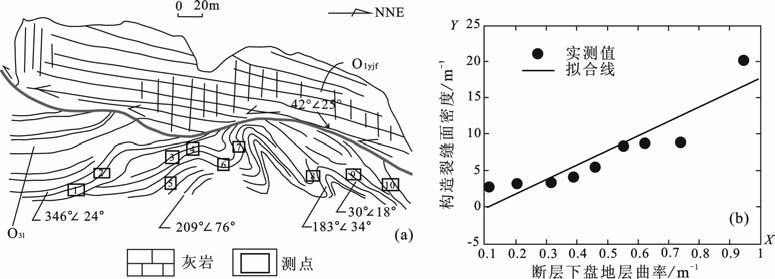
|
图 4 微波塔逆断层(南侧)下盘裂缝实测剖面WBT2和地层曲率线性拟合图 (a)构造裂缝实测剖面;(b)裂缝面密度拟合图. Fig. 4 Profile of structural fracture measurement in the southern foot wall of WBT reverse fault and the itted line between fracture density and the curvature of formation (a) Profile o f structural fracture measurement; (b) Fitted line o f fracture density and the curvature o f formation. |
根据微波塔逆断层(南侧下盘所显示的裂缝密度分布情况可知),褶皱的大曲率测点裂缝面密度较大,如点4、6、7、8,而点10靠近逆断层和高倾角地层的影响,其裂缝面密度也异常较大(表 1),因此点10为奇异点,在线性回归时去掉点10.断层下盘的地层曲率与裂缝面密度的线性拟合图满足方程y=19.4612x-2.0619,其中相关系数r=0.9046.根据微波塔逆断层下盘剖面的构造裂缝面密度与地层曲率的线性关系分析,地层曲率越大的地方其下盘的构造裂缝测点的面密度越大(图 4b).因此,可根据地层曲率预测构造裂缝发育程度的相对大小.
3.1.3 微波塔逆断层(北侧)剖面WBT3分别在微波塔逆断层(北侧)WBT3 剖面上下盘靠近断面的地方选取测点对各测点的构造裂缝面密度进行系统测量(图 5),微波塔逆断层(北侧)剖面显示逆断层下盘(非能干层)的裂缝面密度比上盘(能干层)大,是因为微波塔逆断层上盘地层较厚而下盘地层较薄,薄层中的构造裂缝面密度比厚层要大,裂缝面密度分布与地层层厚有关.

|
图 5 微波塔逆断层(北侧)构造裂缝实测剖面WBT3 Fig. 5 Profile of structural fracture measurementin the northern wall of WBT reverse fault |
另外在逆断层的同一盘断面曲率较大地方构造裂缝面密度更高,可见构造裂缝面密度的分布与断面的曲率密切相关(表 1).下面分别对上下盘各测点裂缝面密度与各测点所在断面曲率进行线性拟合(图 6).
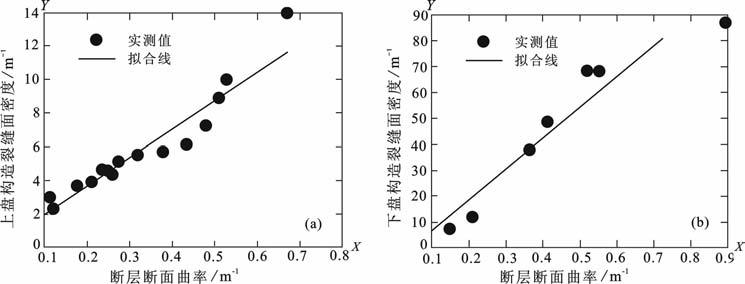
|
图 6 微波塔逆断层(北侧)WBT3剖面构造裂缝面密度和断面曲率的线性拟合图 (a)上盘裂缝面密度和断面曲率的线性拟合图;(b)下盘裂缝面密度和断面曲率的线性拟合图. Fig. 6 Linear fit line of fracture density and the curvature of fault plane (a) Linear I i t line of fracture density and the curvature o I fault plane I or the upper wall;(b) Linear fit line of fracture density and the curvature o f fault plane for the foot wall. |
微波塔逆断层(北侧)剖面上盘面密度和断面曲率满足方程y=17.5142x+0.0952.其中相关系数r=0.9544.根据微波塔逆断层(北侧)上盘剖面构造裂缝面密度与断面曲率的线性关系分析,可知逆断层的断面曲率越大的地方其上盘测点的构造裂缝面密度越大(图 6a).因此,可根据逆断层断面的曲率预测构造裂缝发育程度的相对大小.
微波塔逆断层(北侧)剖面下盘面密度和断面曲率满足方程y=115.5x-3.922.其中相关系数r=0.9518.同样根据微波塔逆断层(北侧)下盘剖面的构造裂缝面密度与断面曲率的线性关系分析,可知断面曲率越大的地方其下盘测点的构造裂缝面密度越大(图 6b).
3.2 一间房南逆断层犢J F2剖面构造裂缝分布规律一间房南的逆断层分布在巴楚隆起北部,位于微波塔逆断层以南15km 处,断面产状为10°∠45°,破碎带宽0.5m.该断层破碎带内发育压性角砾岩、碎裂岩和断层泥,破碎带内劈理发育,指示逆冲方向为西南方向(图 7a).本剖面主要研究逆断层不同构造部位对构造裂缝发育的控制.

|
图 7 -间房南逆断层剖面图和裂缝面密度-距断层距离关系图 (a)构造裂缝实测剖面;(b)裂缝面密度-距离关系图. Fig. 7 Profile o f structural fracture measurement in the southern YJF reverse fault andthe distribution graph o f fracture density (a) Profile o f the southern YJF reverse fault; (b) Relationship of fracture density and distance from the YJF reverse fault |
一间房南YJF2剖面的构造裂缝发育主要受控于该逆断层,在距断层150m 范围内构造裂缝面密度相对较高,并在150 m 左右裂缝面密度急剧下降,而距断层150 m 以外构造裂缝面密度下降缓慢,趋于平稳.断层下盘的牵引形成的褶皱作用,导致点1~3 在局部有逐渐上升的趋势(表 1).宏观上,一间房逆断层对构造裂缝的控制,整体上距断裂越近裂缝密度越高,随着距断裂距离越远裂缝密度逐渐降低(图 7b).本断裂存在一个裂缝密度骤降的临界点,约在距断裂150 m 处.这个临界点非常重要,可能与断裂性质和规模有关,对裂缝分布规律的数学建模和探讨断裂对裂缝密度的强控制范围十分重要.这个150 m 范围内的高裂缝密度带称为"断裂控制的裂缝带",而150 m 以外的区域发育的裂缝面密度较低且变化平缓的裂缝称为"区域控制的裂缝".
不同性质的断层对其附近构造裂缝的控制程度是不同的,例如:走滑断层与逆断层控制构造裂缝的发育程度就有明显的不同.下面对两种性质的断层控制构造裂缝带的宽度进行比较(表 2).
|
|
表 2 三种断裂特征与断层控制裂缝带宽度的关系表 Table 2 Relationship between the fault propertiesand fracture zone controlled by the faults |
断层控制裂缝带宽度与断距的比值可以反映不同性质构造类型对构造裂缝发育的影响.表 2 所列逆断层控制的裂缝带宽度(即高裂缝密度发育区距断层的临界距离)约为150m,逆断层控制裂缝带的宽度与断距比值为1.5.相反,走滑断裂控制的裂缝带的宽度较小,张扭性的皮羌走滑断裂的裂缝带宽为80m,压扭性的西克尔走滑断裂的裂缝带宽约为100m[41].走滑断裂控制裂缝带宽度与断距的比值明显较逆断层小,张扭性的皮羌走滑断裂与压扭性的西克尔走滑断裂分别是0.02和0.33.可以看出,压扭性的走滑断层控制的裂缝带宽度与断距比值也大于张扭性走滑断层.总体看来,压性构造对裂缝带控制的范围比张性构造对裂缝带控制的范围要大得多.
4 结 论我们选取了巴楚地区两个典型逆断层剖面,结合地球物理方法及野外构造测量法对逆断层控制的构造裂缝进行了精细测量,对测量结果的统计分析表明逆断层对构造裂缝的发育程度的控制有明显的规律性.
(1) 根据微波塔逆断层统计分析结果,受逆断层影响的断层附近构造裂缝面密度与断面曲率成正比,断面曲率越大,构造裂缝面密度越大.
(2) 当地层由于牵引作用发生褶皱时,地层曲率越大的地方构造裂缝面密度越大.
(3) 一间房南逆断层对构造裂缝的控制有明显的规律性.整体上距断裂越近构造裂缝面密度越高,距断裂越远裂缝面密度逐渐降低.本断裂存在一个裂缝密度骤降的临界距离(距断层的临界距离),约在距断裂150m 处.这个150m 范围内的高裂缝密度带称为"断裂控制的裂缝带".
(4) 逆断层控制的构造裂缝带的宽度与断距比值远远大于走滑断层,压扭性的走滑断层控制的构造裂缝带的宽度与断距比值又远大于张扭性走滑断层.
致谢感谢参加野外构造裂缝测量的舒武林和鞠玮,张鹏和孟庆峰参与了室内数据处理工作,一并感谢.
| [1] | Fjoer E, Hole R M, Rathore J S. Seismic Anisotropy. SEG, 1996 |
| [2] | 张永刚, 王赟, 王妙月. 目前多分量地震勘探中的几个关键问题. 地球物理学报 , 2004, 47(1): 151–155. Zhang Y G, Wang Y, Wang M Y. Some key problems in the multi-component seismic exploration. Chinese J Geophys (in Chinese) , 2004, 47(1): 151-155. |
| [3] | 方正. 中国煤田勘探地球物理技术. 地球物理学报 , 1994, 37(1): 397–407. Fang Z. Technology of geophysical exploration of Coal in China. Chinese J Geophys (in Chinese) , 1994, 37(1): 397-407. |
| [4] | 李英康, 崔作舟. 分离纵波和横波的偏振旋转法. 地球物理学报 , 1994, 37(Suppl.1): 372–382. Li Y K, Cui Z Z. P and S-wave separated by polarization revolving method. Chinese J Geophys (in Chinese) , 1994, 37(Suppl.1): 372-382. |
| [5] | 刘志, 张先康, 王椿镛, 等. 泰安-忻州剖面S波资料解释及其与邢台地震的相关性分析. 地震学报 , 2000, 15(3): 61–69. Liu Z, Zhang X K, Wang C Y, et al. Geological interpretation of S wave data along the Taian-Xinzhou profile and the correlation analysis of Xingtai earthquake. Acta Seismologica Sinica (in Chinese) , 2000, 15(3): 61-69. |
| [6] | 滕佃波, 邢春颖, 王赟. 基于地震横波分裂理论的火成岩裂缝检测. 地球物理学进展 , 2005, 20(2): 513–517. Teng D B, Xing C Y, Wang Y. The detection of fracture in igneous-rock-reservoir based on S-wave splitting. Progress in Geophysics (in Chinese) , 2005, 20(2): 513-517. |
| [7] | 罗省贤, 李录明. 基于横波分裂的地层裂缝预测方法与应用. 成都理工大学学报(自然科学版) , 2003, 30(1): 52–59. Luo S X, Li L M. Method and application of predicting medium fracture based on shear-wave separating theory. Journal of Chengdu University of Technology (in Chinese) , 2003, 30(1): 52-59. |
| [8] | 李军, 郝天珧. 地震与测井数据综合预测裂缝发育带. 地球物理学进展 , 2006, 21(1): 179–183. Li J, Hao T Y. Synthetic predication of favorable fracture zone from seismic and log data. Progress in Geophysics (in Chinese) , 2006, 21(1): 179-183. |
| [9] | 姚陈, 王培德, 陈运泰. 卢龙地区S波偏振与上地壳裂隙各向异性. 地球物理学报 , 1992, 35(3): 305–315. Yao C, Wang P D, Chen Y T. Shear-wave polarization and crack induced anisotropy of upper crust in Lulong, North China. Chinese J Geophys (in Chinese) , 1992, 35(3): 305-315. |
| [10] | 王萍, 付碧宏, 张斌, 等. 汶川8.0级地震地表破裂带与岩性关系. 地球物理学报 , 2009, 52(1): 131–139. Wang P, Fu B H, Zhang B, et al. Relationships between surface ruptures and lithologic characteristics of the Wenchuan Ms8.0 earthquake. Chinese J Geophys (in Chinese) , 2009, 52(1): 131-139. |
| [11] | Hudson J A. Overall properties of a cracked solid. Math Proc Camb Phil Soc , 1980, 88: 371-384. DOI:10.1017/S0305004100057674 |
| [12] | Hudson J A. Wave speeds and attenuation of elastic waves in material containing cracks. Geophys J Roy Astr Soc , 1981, 64: 133-150. DOI:10.1111/j.1365-246X.1981.tb02662.x |
| [13] | 王仁, 丁中一, 殷有泉. 固体力学基础. 北京: 地质出版社, 1979 : 220 -254. Wang R, Ding Z Y, Yin Y Q. Solid Mechanics Foundation (in Chinese). Beijing: Geological Publishing House, 1979 : 220 -254. |
| [14] | 曾锦光, 罗元华, 陈太源, 等. 应用构造面主曲率研究油气藏裂缝问题. 力学学报 , 1982, 2(2): 202–206. Zeng J G, Luo Y H, Chen T Y, et al. A method for the study of Reservoir fracturing based on structural principal curvatures. Acta Mechanica Sinica (in Chinese) , 1982, 2(2): 202-206. |
| [15] | TD. 范 高尔夫-拉特等.裂缝油藏工程基础.陈钟祥,金铃年,秦同洛译.北京:石油工业出版社,1989 Golf-Racht T D V, et al. Fundamentals of Fractured Reservoir Engineering (in Chinese). Translated by Chen Z X, Jin L N, Qin T L. Beijing: Petroleum Industry Press, 1989 |
| [16] | 侯贵廷. 裂缝的分形分析方法. 应用基础与工程科学学报 , 1994, 2(4): 299–305. Hou G T. Fractal analysis of fractures. Journal of Basic Science and Engineering (in Chinese) , 1994, 2(4): 299-305. |
| [17] | 姚姚, 唐文榜. 深层碳酸盐岩岩溶风化壳洞缝型油气藏可检测性的理论研究. 石油地球物理勘探 , 2003, 38(6): 623–629. Yao Y, Tang W B. Theoretical research on the detectability of Karst fracture and cavern pools. Oil Geophysical Prospecting (in Chinese) , 2003, 38(6): 623-629. |
| [18] | 景建恩, 魏文博, 梅忠武, 等. 裂缝型碳酸盐岩储层测井评价方法——以塔河油田为例. 地球物理学进展 , 2005, 20(1): 78–82. Jing J E, Wei W B, Mei Z W, et al. Method of Well-logging interpretation for fracture reservoirs of carbonate rock—A case study in Tahe oil-field. Progress in Geophysics (in Chinese) , 2005, 20(1): 78-82. |
| [19] | 彭建兵, 陈立伟, 黄强兵, 等. 地裂缝破裂扩展的大型物理模拟试验研究. 地球物理学报 , 2008, 51(6): 1826–1834. Peng J B, Chen L W, Huang Q B, et al. Large-scale physical simulative experiment on ground-fissure expansion mechanism. Chinese J Geophys (in Chinese) , 2008, 51(6): 1826-1834. |
| [20] | 王孔伟.塔里木盆地巴楚-阿瓦提地区构造特征与构造演化[博士论文].长春:吉林大学,2007 Wang K W. The structural feature and tectonic evolution about Bachu-Awati Area in Tarim Basin[Ph.D. thesis] (in Chinese). Changchun: Jilin University, 2007 http://cdmd.cnki.com.cn/Article/CDMD-10183-2007095788.htm |
| [21] | 杨庚, 郭华. 塔里木盆地西北缘柯坪逆冲构造带与巴楚隆起的叠加关系. 铀矿地质 , 2003, 19(1): 1–7. Yang G, Guo H. Superposed relationship between Kalping thrust belt and Bachu uplift, northwest Tarim. Uranium Geology (in Chinese) , 2003, 19(1): 1-7. |
| [22] | 杨庚, 石昕, 贾承造, 等. 塔里木盆地西北缘柯坪-巴楚地区皮羌断裂与色力布亚断裂空间关系. 铀矿地质 , 2008, 24(4): 201–205. Yang G, Shi X, Jia C Z, et al. Spatial relationship between Piqiang fault and Selibuya fault in Keping-Bachu district, northwest Tarim basin. Uranium Geology (in Chinese) , 2008, 24(4): 201-205. |
| [23] | 何文渊, 李江海, 钱祥麟, 等. 塔里木盆地柯坪断隆断裂构造分析. 中国地质 , 2002, 29(1): 37–42. He W Y, Li J H, Qian X L, et al. Analysis of fault structures in the Kalpin fault uplift, Tarim basin. Geology in China (in Chinese) , 2002, 29(1): 37-42. |
| [24] | Allen M B, Vencent S J, Wheller P J. Late Cenozoic tectonics of the Kepingtage thrust zone: interactions of Tianshan and Tarim Basin, Northwest China. Tectonics , 1999, 18(4): 639-654. DOI:10.1029/1999TC900019 |
| [25] | Nishidai T, Berry J L. Structure and hydrocarbon potential of the Tarim Basin. Journal of Petroleum Geology , 1990, 13(1): 35-58. DOI:10.1111/jpg.1990.13.issue-1 |
| [26] | 杨晓平, 冉勇康, 宋方敏, 等. 西南天山柯坪逆冲推覆构造带的地壳缩短分析. 地震地质 , 2006, 28(2): 194–203. Yang X P, Ran Y K, Song F M, et al. The analysis for crust shortening of Kalping thrust tectonic zone, South-western Tianshan, Xinjiang, China. Seismology and Geology (in Chinese) , 2006, 28(2): 194-203. |
| [27] | 肖安成, 杨树锋, 王清华, 等. 塔里木盆地巴楚—柯坪地区南北向断裂系统的空间对应性研究. 地质科学 , 2002, 37(Suppl.1): 64–72. Xiao A C, Yang S F, Wang Q H, et al. Corresponding relation of S-N-striking fault systems in the Bachu-Kalpin area, Tarim basin. Chinese Journal of Geology (in Chinese) , 2002, 37(Suppl.1): 64-72. |
| [28] | McKnight C L, Carrolla A R, Chu J, et al. Stratigraphy and structure of the Kalpin uplift, Tarim basin, northwest China. Seventh Thematic Conference on Remote Sensing for Exploration Geology. Environmental Research Institute of Michigan , 1989: 1085-1096. |
| [29] | 陈杰, 曲国胜, 胡军, 等. 帕米尔北缘弧形推覆构造带东段的基本特征与现代地震活动. 地震地质 , 1997, 19(4): 301–312. Chen J, Qu G S, Hu J, et al. Arcuate thrust tectonics and its contemporary seismicity in the Eastern section of the external zone of the Parmir. Seismology and Geology (in Chinese) , 1997, 19(4): 301-312. |
| [30] | 宋方敏, 闵伟, 韩竹军, 等. 南天山柯坪塔格推覆体前缘断裂活动性质及速率. 地震地质 , 2007, 29(2): 272–279. Song F M, Min W, Han Z J, et al. Activities and slip rate of the frontal faults of the Kalpintag nappe, Tianshan mountains, China. Seismology and Geology (in Chinese) , 2007, 29(2): 272-279. |
| [31] | 曲国胜, 李亦纲, 陈杰, 等. 柯坪塔格推覆构造几何学、运动学及其构造演化. 地学前缘 , 2003, 10(增): 142–150. Qu G S, Li Y G, Chen J, et al. Geometry, kinematics and tectonic evolution of Kepingtage thrust system. Earth Science Frontiers (in Chinese) , 2003, 10(增): 142-150. |
| [32] | 张培震, 邓启东, 杨晓平, 等. 天山的晚新生代构造变形及其地球动力学问题. 中国地震 , 1996, 12(2): 127–140. Zhang P Z, Deng Q D, Yang X P, et al. Late Cenozoic tectonic deform action and mechanism along the Tianshan Mountain, Northwestern China. Earthquake Research in China (in Chinese) , 1996, 12(2): 127-140. |
| [33] | Murray G H. Quantitative fracture study, Sanish pool, McKenzie County, North Dakota. AAPG Bull , 1968, 52(1): 57-65. |
| [34] | 宋慧珍, 贾承造. 裂缝性储集层研究理论与方法. 石油工业出版社: 2001 : 12 -26. Song H Z, Jia C Z. Research Theory and Method of Fractured Reservoir (in Chinese). Beijing: Petroleum Industry Press (in Chinese). 2001 : 12 -26. |
| [35] | 张帆, 贺振华. 预测裂隙发育带的构造应力场数值模拟技术. 石油地球理勘探 , 2000, 35(2): 154–163. Zhang F, He Z H. Structural stress field numerical simulation technique for fracture zone prediction. Oil Geophysical Prospecting (in Chinese) , 2000, 35(2): 154-163. |
| [36] | 秦启荣, 苏培东. 构造裂缝类型划分与预测. 天然气工业 , 2006, 10: 33–36. Qin Q R, Su P D. Classification and prediction of structural fractures types. Natural Gas Industry (in Chinese) , 2006, 10: 33-36. |
| [37] | Lorenz J C, Lawrence W T, Warpinski N R. Regional fracture I: a mechanism for the formation of regional fractures at depth in flat-lying reservoirs. AAPG Bull , 1991, 75(11): 1714-1737. |
| [38] | 周新桂, 邓宏文, 操成杰, 等. 储层构造裂缝定量预测研究及评价方法. 地球学报 , 2003, 24(2): 175–180. Zhou X G, Deng H W, Cao C J, et al. The methods for quantitative prediction and evaluation of structural fissures in reservoirs. Acta Geoscientia Sinica (in Chinese) , 2003, 24(2): 175-180. |
| [39] | 魏永佩, 张之一. 油气田裂缝密度定量研究方法. 西安地质学院学报 , 1991, 13(1): 37–40. Wei Y P, Zhang Z Y. The quantitative analysis method of the fracture density in the oil and gas field. Journal of Earth Sciences and Environment (in Chinese) , 1991, 13(1): 37-40. |
| [40] | Mc Quillan H. Small-scale fracture density in Asmari Formation of southwest Iran. Am Assoc Petroleum Geologists , 1973, 57(12): 2367-2385. |
| [41] | 张庆莲, 侯贵廷, 潘文庆, 等. 新疆巴楚地区走滑断裂对碳酸盐岩构造裂缝发育的控制. 地质通报 , 2010, 29(8): 1160–1167. Zhang Q L, Hou G T, Pan W Q, et al. Development of fractures in carbonate rocks under the influence of strike-slip faults in Bachu area, Xinjiang, China. Geological Bulletin of China (in Chinese) , 2010, 29(8): 1160-1167. |
 2011, Vol. 54
2011, Vol. 54



